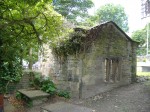 More than one hundred feet of gravestones, paving stones and coping stones have been stolen from the churchyard of the Old Bell Chapel (also known as the Brontë Bell Chapel because Patrick Brontë, father of the literary sisters, was the curate there from 1815 to 1820) in the West Yorkshire village of Thornton. It appears to have been a multi-stage plan involving multiple robbers.
More than one hundred feet of gravestones, paving stones and coping stones have been stolen from the churchyard of the Old Bell Chapel (also known as the Brontë Bell Chapel because Patrick Brontë, father of the literary sisters, was the curate there from 1815 to 1820) in the West Yorkshire village of Thornton. It appears to have been a multi-stage plan involving multiple robbers.
 Members of the Old Bell Chapel Action Group, who have worked assiduously for 12 years to restore this historic chapel and cemetery from 150 years of neglect into a beautiful, welcoming site for history, nature and literature buffs alike to enjoy, first saw that coping stones had been torn from a wall outside the chapel on Wednesday, October 17th. On the morning of Saturday the 20th, they arrived to find even more devastation: paving stones from the Brontë Way footpath had been pried up and stolen, as were three horizontal grave slabs and 15 grave toppers from the cemetery.
Members of the Old Bell Chapel Action Group, who have worked assiduously for 12 years to restore this historic chapel and cemetery from 150 years of neglect into a beautiful, welcoming site for history, nature and literature buffs alike to enjoy, first saw that coping stones had been torn from a wall outside the chapel on Wednesday, October 17th. On the morning of Saturday the 20th, they arrived to find even more devastation: paving stones from the Brontë Way footpath had been pried up and stolen, as were three horizontal grave slabs and 15 grave toppers from the cemetery.
 The grave slabs are huge, each of them six feet long, three feet wide, and four to six inches deep. Two have been marking the final resting places of the children of John and Mary Pickles and the daughter of Hannah and James Abbott since the 1820s. The third grave slab does not have a name inscribed, but it dates to 1790. It must have required a great deal of strength to pry up and remove these heavy slabs of solid rock. Police estimate that you would need four men to lift just one of them. The 15 York stone grave toppers
The grave slabs are huge, each of them six feet long, three feet wide, and four to six inches deep. Two have been marking the final resting places of the children of John and Mary Pickles and the daughter of Hannah and James Abbott since the 1820s. The third grave slab does not have a name inscribed, but it dates to 1790. It must have required a great deal of strength to pry up and remove these heavy slabs of solid rock. Police estimate that you would need four men to lift just one of them. The 15 York stone grave toppers stolen are not as large as the gravestones, but are nonetheless ponderous, heavy pieces. This isn’t the kind of thing you’d do on the spur of the moment. The theft required tools, organization and manpower, in addition to a callous disregard for history and human dignity, of course.
stolen are not as large as the gravestones, but are nonetheless ponderous, heavy pieces. This isn’t the kind of thing you’d do on the spur of the moment. The theft required tools, organization and manpower, in addition to a callous disregard for history and human dignity, of course.
 Police ask that anyone with information about the thefts contact the North Bradford Neighbourhood Policing Team by calling 101. You can also report anything suspicious to CrimeStoppers at 0800 555 111. Meanwhile, police are patrolling the grounds regularly and have reached out to local stonemasons asking them to report anybody attempting to sell the looted stones. The large grave slabs are inscribed, some in more detail than the headstones, so they’ll be impossible to sell to
Police ask that anyone with information about the thefts contact the North Bradford Neighbourhood Policing Team by calling 101. You can also report anything suspicious to CrimeStoppers at 0800 555 111. Meanwhile, police are patrolling the grounds regularly and have reached out to local stonemasons asking them to report anybody attempting to sell the looted stones. The large grave slabs are inscribed, some in more detail than the headstones, so they’ll be impossible to sell to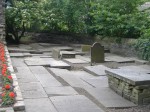 buyers with any sense and morals. The paving and coping stones, on the other hand, have no distinguishing marks. Recycled York stone, the older the better, is an extremely popular material for landscape design and decorative construction. It’s durable and weathers beautifully.
buyers with any sense and morals. The paving and coping stones, on the other hand, have no distinguishing marks. Recycled York stone, the older the better, is an extremely popular material for landscape design and decorative construction. It’s durable and weathers beautifully.
 The Old Bell Chapel Action Group is hoping against hope that at least the gravestones, which are irreplaceable, may be found discarded somewhere. The publicity this dastardly act has garnered may hinder the robbers’ attempts to profit and force them to dump the highly recognizable pieces. Meanwhile, the organization is looking into security cameras and SmartWater, an ingenious anti-theft liquid that contains microscopic chemical particles encoded with a unique signature that glows under UV light. It identifies stolen property like DNA identifies people, and when found on a suspect, it ties them conclusively to the stolen object or the place where it was stolen.
The Old Bell Chapel Action Group is hoping against hope that at least the gravestones, which are irreplaceable, may be found discarded somewhere. The publicity this dastardly act has garnered may hinder the robbers’ attempts to profit and force them to dump the highly recognizable pieces. Meanwhile, the organization is looking into security cameras and SmartWater, an ingenious anti-theft liquid that contains microscopic chemical particles encoded with a unique signature that glows under UV light. It identifies stolen property like DNA identifies people, and when found on a suspect, it ties them conclusively to the stolen object or the place where it was stolen.
These security measures cost money, money which this small, dedicated group of history lovers does not have. To donate, call Steve Stanworth at 07786 028 889 or email at this address. You can also follow them on Facebook to stay apprised of the investigation and rebuilding efforts.
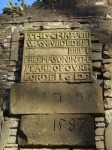 The Action Group had already increased fundraising efforts this year, selling commemorative plates and some lovely Christmas cards in honor of the 400th anniversary of the construction of Old Bell Chapel. There was an even earlier church known as Saint Leonard’s built in 1587 (the date stone is part of the walls of the chapel today), but in 1612 it was rebuilt from scratch and called Saint James’ Church.
The Action Group had already increased fundraising efforts this year, selling commemorative plates and some lovely Christmas cards in honor of the 400th anniversary of the construction of Old Bell Chapel. There was an even earlier church known as Saint Leonard’s built in 1587 (the date stone is part of the walls of the chapel today), but in 1612 it was rebuilt from scratch and called Saint James’ Church.
 By the time Patrick Brontë arrived 200 years later, the chapel was dilapidated. The growing Dissenter movements of the 17th and 18th centuries had turned many people from the small, cramped Anglican church to its Independent Congregationalist competition, the Kipping Chapel. It was still a popular spot for burials, though. The churchyard has seen 6000 burials from 1597 until the last one in 1965, and up until Patrick’s time, people could pay extra and be buried under the floor of the church itself. Brontë put a stop to that practice because it was making the church smell awful. He also spearheaded a major renovation of the church in 1818, rebuilding the south walls with windows and erecting a bell tower.
By the time Patrick Brontë arrived 200 years later, the chapel was dilapidated. The growing Dissenter movements of the 17th and 18th centuries had turned many people from the small, cramped Anglican church to its Independent Congregationalist competition, the Kipping Chapel. It was still a popular spot for burials, though. The churchyard has seen 6000 burials from 1597 until the last one in 1965, and up until Patrick’s time, people could pay extra and be buried under the floor of the church itself. Brontë put a stop to that practice because it was making the church smell awful. He also spearheaded a major renovation of the church in 1818, rebuilding the south walls with windows and erecting a bell tower.
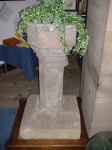 Although the nearby village of Haworth where the children grew up and Emily and Charlotte would write their masterpieces is more widely associated with Patrick’s clutch of world-famous children, the five of them born during his curacy of St. James’ Church were baptized there: Elizabeth (baptized August 26th, 1815), Charlotte (June 29th, 1816), Patrick Branwell (July 23rd, 1817), Emily (August 26th, 1818) and Ann (March 25th, 1820). The baptismal font they all used still exists. It has been moved across the street to the current Saint James’ Church, built in 1872 to replace the old church which had fallen into disrepair after Patrick Brontë took the Perpetual Curacy of Haworth and moved the family there in April 1820.
Although the nearby village of Haworth where the children grew up and Emily and Charlotte would write their masterpieces is more widely associated with Patrick’s clutch of world-famous children, the five of them born during his curacy of St. James’ Church were baptized there: Elizabeth (baptized August 26th, 1815), Charlotte (June 29th, 1816), Patrick Branwell (July 23rd, 1817), Emily (August 26th, 1818) and Ann (March 25th, 1820). The baptismal font they all used still exists. It has been moved across the street to the current Saint James’ Church, built in 1872 to replace the old church which had fallen into disrepair after Patrick Brontë took the Perpetual Curacy of Haworth and moved the family there in April 1820.
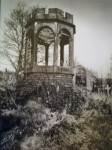 It was a crumbling ruin ceded to the wilderness when the Old Bell Chapel Action Group took it upon themselves to clear and preserve it starting in 2000. They cleared the brush, revealing the remaining walls of the chapel and opening the cemetery so locals could visit their ancestors’ and relatives’ graves and Brontë lovers could pay homage to where it all began.
It was a crumbling ruin ceded to the wilderness when the Old Bell Chapel Action Group took it upon themselves to clear and preserve it starting in 2000. They cleared the brush, revealing the remaining walls of the chapel and opening the cemetery so locals could visit their ancestors’ and relatives’ graves and Brontë lovers could pay homage to where it all began.
Sad. Here in the US stuff like that disappears on halloween so that people can decorate for Halloween. I hope they find those inconsiderate idiots.
I doubt this was decoration run. It’s just too much trouble getting those massive slabs up. I hope they find them too and get every last stone back.
:angry:
:yes:
Sometimes this grave business works happily the other way. People tidying up at the Kensal Green cemetery recently came across the long lost grave of Col. Francis Maceroni and were able to bring it back to life (so to speak).
The story is found in pdf form at this site. (I get most of the file, followed by weird error messages from Adobe, but you might be luckier.)
“Cursed be the man that moves my bones” is a epitaph that comes to mind. It takes a man with no scruples and one that lacks much in his character to remove anything of value from a cemetery. I would hope that the guilty party will at some time in the future suffer severely with a guilty conscience. Chickens still come home to roost,I hope.